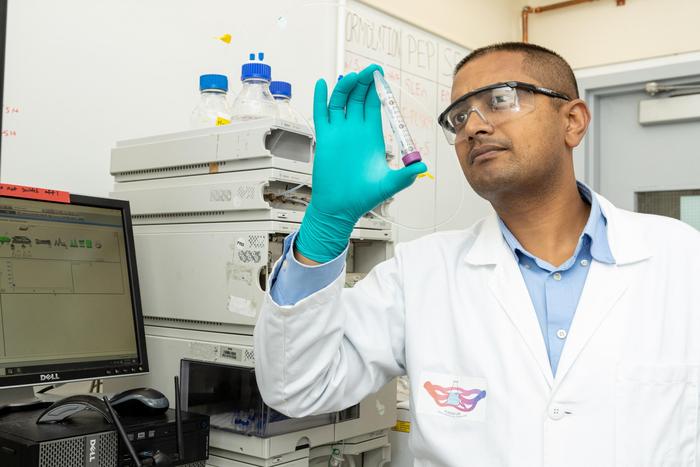Forging partnerships in the Americas: Naval leaders gather at SIANC S&T Conference
ARLINGTON, Va.—For Dr. Brett Seidle — the deputy assistant secretary of the Navy for Research, Development, Test and Engineering — the breakneck speed of current scientific progress and technological proliferation can be challenging, especially when the impact of new technologies on civilian and military realities transcends national borders. While giving the keynote address at the […]

ARLINGTON, Va.—For Dr. Brett Seidle — the deputy assistant secretary of the Navy for Research, Development, Test and Engineering — the breakneck speed of current scientific progress and technological proliferation can be challenging, especially when the impact of new technologies on civilian and military realities transcends national borders.
While giving the keynote address at the recent Specialized Inter-American Naval Conference on Science, Technology and Innovation (SIANC-ST&I) in Orlando, Florida, Seidle identified several scientific disciplines that have developed into top naval priorities: unmanned and autonomous systems, cyber and information warfare, and maritime domain awareness, to name a few.
“If we do not have people who understand both how these technologies work and why they are so important, we will cede our technological edge to our pacing threats,” said Seidle. “We need innovators and strategic thinkers who know not only how to fight wars, but also how to prevent them from happening in the first place.”
Sponsored by the Office of Naval Research (ONR) Global — ONR’s international arm — this year’s SIANC-ST&I featured representatives from 14 participating nations from North, Central and South America and two international organizations: Inter-American Defense Board and Inter-American Naval Telecommunications Network. The purpose of the conference is two-fold: support mutual maritime science and technology (S&T) interests among partner nations; and strengthen relationships, coordination and interoperability.
This year’s SIANC-ST&I was the ninth in its 27-year history and marked the first time the event was held in the United States.
During his address, Seidle discussed the importance of fostering greater innovation to meet global challenges; investing more in joint research between allied nations; and the responsibility of SIANC-ST&I participating countries to not only focus on their own aspirations in defense research, but also to promote enduring partnerships with all nations of the Americas.
In keeping with this year’s conference theme, “Naval Force Integration with Unmanned Systems,” Chief of Naval Research Rear Adm. Lorin Selby spoke about how, in the coming years, the U.S. Navy and Marine Corps will encounter new challenges to their operational capabilities. These obstacles will require naval forces that are innovative, agile and ready to adapt to new realities.
Selby’s remarks built on “The Defining Decade: The Future is Now” speech he gave last month at the Navy League’s Sea-Air-Space Exposition, the largest maritime expo in the United States, held at the Gaylord National Resort and Convention Center in Maryland. Learn more about this speech at https://www.nre.navy.mil/media-center/news-releases/defining-decade-cnr-talks-future-naval-power-sea-air-space.
“We live in a world where U.S. technological advantage is being threatened, which in turn threatens our allies and partner nations,” Selby said at SIANC-ST&I. “It is imperative that we foster international collaboration and joint experimentation, in order to establish greater global security.”
During SIANC-ST&I, representatives broke out into three working groups — unmanned systems, knowledge management and common operational picture — to consider specific activities, including organizing workshops and integrating technologies into their own regular exercises, to enhance interoperability with other maritime forces and incorporate exciting S&T innovations into their research investments.
At the end of the conference, partner nations signed a final resolution summarizing discussions, with declarations, recommendations and action items for the next two years, for review and approval by the Heads of Navies in September 2024 during the Inter-American Naval Conference.
“At ONR and ONR Global, we’re proud of our culture of innovation and commitment to strengthening partnerships that benefit our Navy and Marine Corps,” said ONR Global Technical Director Dr. Rhett Jefferies. “We discover potentially game-changing science in the smallest corners of the world and strive to connect those innovative researchers to the Naval Research Enterprise. The S&T collaboration engendered during the SIANC ST&I is vital for our collective security in the Western Hemisphere.”
Other highlights from the conference included scientific presentations by students from the University of Central Florida and Embry-Riddle Aeronautical University; a tour of the Kennedy Space Center, followed by a hosted reception at the Atlantis Space Shuttle exhibit, where the participants met retired astronaut Lt. Col. Andrew Allen (USMC, ret.); and a trip to the Central Florida Tech Grove innovation center, which hosts multiple joint projects with the Naval Air Warfare Center Training Systems Division.

Credit: (U.S. Navy photo by Michael Walls)
ARLINGTON, Va.—For Dr. Brett Seidle — the deputy assistant secretary of the Navy for Research, Development, Test and Engineering — the breakneck speed of current scientific progress and technological proliferation can be challenging, especially when the impact of new technologies on civilian and military realities transcends national borders.
While giving the keynote address at the recent Specialized Inter-American Naval Conference on Science, Technology and Innovation (SIANC-ST&I) in Orlando, Florida, Seidle identified several scientific disciplines that have developed into top naval priorities: unmanned and autonomous systems, cyber and information warfare, and maritime domain awareness, to name a few.
“If we do not have people who understand both how these technologies work and why they are so important, we will cede our technological edge to our pacing threats,” said Seidle. “We need innovators and strategic thinkers who know not only how to fight wars, but also how to prevent them from happening in the first place.”
Sponsored by the Office of Naval Research (ONR) Global — ONR’s international arm — this year’s SIANC-ST&I featured representatives from 14 participating nations from North, Central and South America and two international organizations: Inter-American Defense Board and Inter-American Naval Telecommunications Network. The purpose of the conference is two-fold: support mutual maritime science and technology (S&T) interests among partner nations; and strengthen relationships, coordination and interoperability.
This year’s SIANC-ST&I was the ninth in its 27-year history and marked the first time the event was held in the United States.
During his address, Seidle discussed the importance of fostering greater innovation to meet global challenges; investing more in joint research between allied nations; and the responsibility of SIANC-ST&I participating countries to not only focus on their own aspirations in defense research, but also to promote enduring partnerships with all nations of the Americas.
In keeping with this year’s conference theme, “Naval Force Integration with Unmanned Systems,” Chief of Naval Research Rear Adm. Lorin Selby spoke about how, in the coming years, the U.S. Navy and Marine Corps will encounter new challenges to their operational capabilities. These obstacles will require naval forces that are innovative, agile and ready to adapt to new realities.
Selby’s remarks built on “The Defining Decade: The Future is Now” speech he gave last month at the Navy League’s Sea-Air-Space Exposition, the largest maritime expo in the United States, held at the Gaylord National Resort and Convention Center in Maryland. Learn more about this speech at https://www.nre.navy.mil/media-center/news-releases/defining-decade-cnr-talks-future-naval-power-sea-air-space.
“We live in a world where U.S. technological advantage is being threatened, which in turn threatens our allies and partner nations,” Selby said at SIANC-ST&I. “It is imperative that we foster international collaboration and joint experimentation, in order to establish greater global security.”
During SIANC-ST&I, representatives broke out into three working groups — unmanned systems, knowledge management and common operational picture — to consider specific activities, including organizing workshops and integrating technologies into their own regular exercises, to enhance interoperability with other maritime forces and incorporate exciting S&T innovations into their research investments.
At the end of the conference, partner nations signed a final resolution summarizing discussions, with declarations, recommendations and action items for the next two years, for review and approval by the Heads of Navies in September 2024 during the Inter-American Naval Conference.
“At ONR and ONR Global, we’re proud of our culture of innovation and commitment to strengthening partnerships that benefit our Navy and Marine Corps,” said ONR Global Technical Director Dr. Rhett Jefferies. “We discover potentially game-changing science in the smallest corners of the world and strive to connect those innovative researchers to the Naval Research Enterprise. The S&T collaboration engendered during the SIANC ST&I is vital for our collective security in the Western Hemisphere.”
Other highlights from the conference included scientific presentations by students from the University of Central Florida and Embry-Riddle Aeronautical University; a tour of the Kennedy Space Center, followed by a hosted reception at the Atlantis Space Shuttle exhibit, where the participants met retired astronaut Lt. Col. Andrew Allen (USMC, ret.); and a trip to the Central Florida Tech Grove innovation center, which hosts multiple joint projects with the Naval Air Warfare Center Training Systems Division.
What's Your Reaction?

































